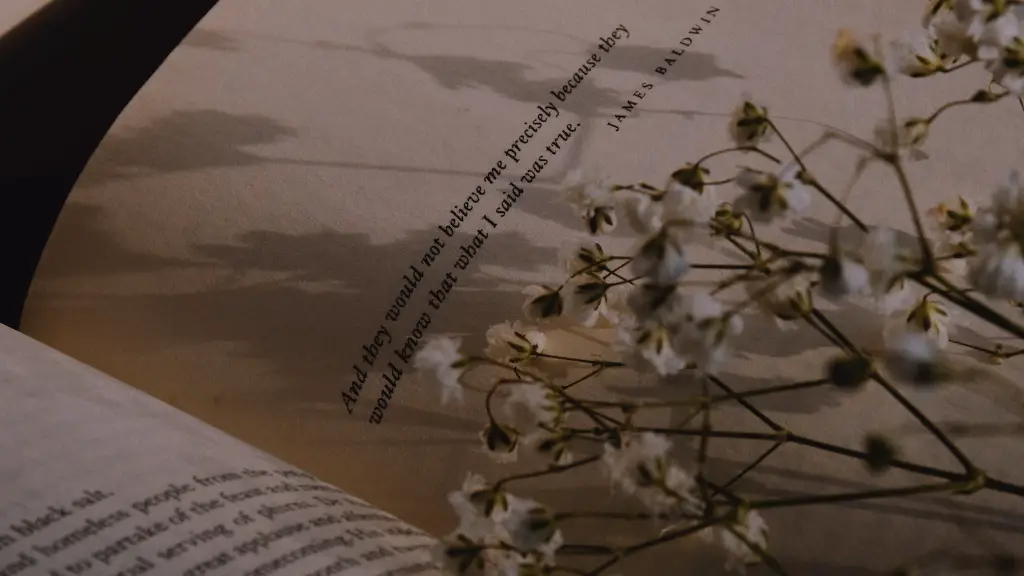Examine rhyme patterns and language play
Poetry is an art form that requires the mastery of many techniques to express ideas in an engaging and visually-pleasing manner. It takes practice, dedication and the willingness to explore different tools to write effective poems. It is important to evaluate existing works and explore existing formats and formulae to develop an understanding of what works and what doesn’t. One of the most important skills to hone in order to write better poetry is to examine the various rhyme patterns and language play already used in existing works.
When writing poetry, it is important to consider each word as if it were the last. Remember, even if the words appear simple, their connotations can have a profound effect on the reader. A word that is seemingly straightforward can quickly become loaded with meaning and emotion if used incorrectly. To ensure this does not happen, it pays to read through and revise the poem multiple times. Exploring different rhyme patterns and alliterations should also be done to make the words ‘flow’ in a manner that will engage readers.
Different rhyme patterns and figurative language, such as metaphors and similes, can also help to create interesting and unique poems. Rhyme patterns are an essential component of poetry and while they may appear to be simple, they can be adapted and tailored to suit particular poems. Likewise, the use of figurative language can also help to convey ideas and emotions in a more powerful and meaningful way.
The use of editing and reviews
When writing poetry, it is important to make sure the work is edited multiple times to correct mistakes and ensure it flows properly. The editing process is also a great time to consider what can be added to the poem to make it even better. Seeking the advice of experienced poets or literary critics is also key to the success of the poem. Reviews of the poem allow for feedback from an unbiased perspective and can provide invaluable insights into where improvement might be made.
The editing process does not have to be a daunting one. Poets should keep in mind that it is a learning experience and should be approached in an open and constructive way. Consider reading the poem out loud to identify patterns or assess the overall tone of the piece. This helps to get an impression of how the words interact with each other and how this could be developed further. Writers should also note any areas which felt awkward or difficult to read and make changes accordingly.
Reflections and further development
Writing and rewriting the poem can be a great way to further hone writing skills and deepen the poem’s themes. After editing, it pays to reflect on the work and think about how the poem could be developed further. Poets can use this time to brainstorm ideas for further development and make any changes as necessary.
It also helps to read and discuss the poem with others. Exploring the poem’s meaning with a group or a mentor can help identify areas that may need more clarity or where further development could take place. Discussing the poem in this manner can also help uncover hidden meanings or themes that could have been missed previously.
Exploring other forms of poetry to derive deeper meaning
Poetry is far from a one size fits all format and there are many different types from which to choose. It is important to explore different forms to develop a broader range of writing and technical skills. The haiku is a good example of a particular form that many poets enjoy exploring. Haikus are often thoughtful and thought-provoking with well-crafted lines that express powerful emotions.
The villanelle is another form of poetry that has been used for centuries to explore themes of love, loss and mortality. It requires a combination of structure, language and figures of speech which can make this form of poem particularly engaging and emotionally evocative. It also encourages creativity, as villanelles often include a complex interlocking of rhymes to create a musical and elegant experience for the reader.
Considering audience, purpose and form
When writing a poem, it is important to consider the audience, purpose and form of the work. Each element must be given attention to ensure the poem expresses the intended idea in an effective and meaningful way.
When considering the audience, it helps to think about who would be interested in the poem and how it might affect them. The purpose of the poem also needs to be considered; why is it being written and how will it be used? The form of the poem should also be considered. Will it follow a specific format or be more free-form? Knowing the audience and purpose will help the poet decide the appropriate form for the poem.
Challenging yourself with experimentation and feedback
Experimenting with different styles and forms of poetry can help poets discover what works for them and what does not. It also helps to create a whole new level of understanding about poetry to help build confidence in one’s own work.
When trying new styles, forms or techniques, it is important to take note of the reactions from other poets and readers. Feedbacks can help poets to understand which elements are working and which elements may not be suitable or require further development. Taking opinions into account helps to make the poem even better and increases the chances of success.
Exploring the use of imagery and symbolism
The use of imagery and symbolism can add an extra layer of depth and meaning to a poem. Imagery helps to bring complex emotions to the surface, while symbolism allows readers to read and interpret poems in new and creative ways.
When using imagery, it is important to get it right, as pictures that are too vivid or too abstract can be less effective. The imagery should aid the poem’s message and not be overwhelming. Similarly, the use of symbols should be carefully considered, as too many symbols can make the poem confusing. It is important to choose symbols that carry the meaning of the poem and are not just decorative.
Conveying messages through metaphors and similes
Metaphors and similes are excellent tools for conveying a message in a vivid and memorable way. Metaphors and similes can improve the quality of a poem, as these figures of speech can bring a poem to life and add pleasure to the reading experience.
When using metaphors and similes, it is important to select ones that are suitable for the poem and complement its narrative. Similarly, they should be relevant to the poem’s topic and stay within its theme. As with other techniques, it pays to look at existing works and experiment with new metaphors and similes to bring a deeper level of understanding.
Exploring themes and subtexts
Writing about themes and subtexts adds another layer of depth to a poem and ensures that it retains its lasting appeal. Exploring themes requires the poet to analyse their own life experiences, thoughts and feelings. This allows the poet to weave a narrative that reflects their own journey and establishes the poem’s unique personality.
Researching existing works to gain a better understanding of the different themes can also be beneficial. Examining how other poets have tackled similar themes can help provide a different perspective on the subject. As with other techniques, it pays to experiment with different ideas in order to discover ones that best expresses the desired message.
Utilising punctuation and line breaks
Punctuation and line breaks can be powerful tools for conveying meaning and emotion. Punctuation marks are often used to create pauses and lay emphasis on particular words. Line breaks are used to break up the poem’s structure and give it a sense of tempo, allowing it to flow in the desired manner.
Using punctuation and line breaks strategically can make a poem more engaging and enjoyable for the reader. It helps to create a clearer structure and makes the poem easier to read and understand. The poet can also experiment with punctuation and line breaks to create a unique style and mood for their poem.


